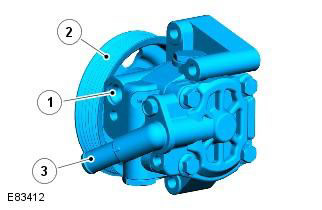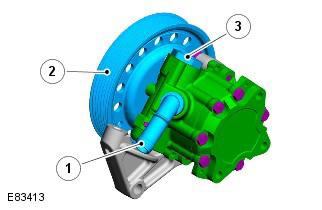Power Steering Pump - TD4

| Pos. | spare part no | Name |
| 1 | - | Injection outlet (to steering valve block) |
| 2 | - | Pulley |
| 3 | - | suction port (from the tank) |
A variable displacement vane pump supplies the required hydraulic pressure to the steering valve block. The pump is located at the front of the engine and is driven by a front accessory V-ribbed belt driven directly from the crankshaft. Pump flow increases in proportion to the load applied to the steering valve block. To maintain the required belt tension, a self-adjusting tensioner is used.
The pump includes 11 blades and a rotor. They are mounted on the input shaft and surrounded by a variable volume stator ring. The blades rotate inside the stator ring and are driven by a shaft. As the blades rotate, the space between the blades increases due to the stator ring. This causes a vacuum between the blades, due to which liquid from the tank is drawn into this space through the suction hose. As the shaft rotates, the inlet of the blades, between which there is already liquid, closes, "locking" thus the liquid between the vanes. Thanks to the stator ring, the space between the vanes is reduced, which leads to compression of the liquid between the vanes. With further rotation of the shaft, the blades turn towards the outlet. As the vanes pass past the orifice, fluid flows under pressure from the pump outlet through the delivery hose to the steering gear.
The stator ring moves inside the valve body. By moving the stator ring, it is possible to change the eccentricity of the shaft and blades in relation to the stator ring. Decreasing the eccentricity reduces the volume of hydraulic fluid between the vanes, thereby maintaining a constant flow of fluid. This reduces the power and torque required to turn the pump and thus improves economy. The pump has an internal control valve that controls the eccentricity of the stator ring and thereby changes the fluid flow according to demand.
At low engine speeds, the internal volume of the variable displacement pump reaches its maximum value to create a controlled fluid supply. As the engine speed increases, the pump speed increases. The increased flow inside the pump creates back pressure in the pump. This back pressure causes the internal control valve to move the cam ring and reduce the internal volume of the pump to keep the pump flow constant.
The regulating pressure reducing valve inside the pump limits the maximum pressure supplied to the steering gear to 115 bar (1667 lbf inch2) ± 4 bar (58 lbf inch2) and also limits the maximum flow to 8.8 l/min (1.93 gpm) ± 0.5 l/min (0.1 gpm) at 10 bar (145 lbf inch2). Pump Displacement 9.6 cc/rev (0.58"3 /rev).
Power Steering Pump - i6

| Pos. | spare part no | Name |
| 1 | - | suction port (from the tank) |
| 2 | - | Pulley |
| 3 | - | Injection outlet (to steering valve block) |
A fixed displacement vane pump supplies hydraulic pressure to the steering gear valve block. The pump is located at the rear of the engine and is driven by a rear accessory V-ribbed belt driven indirectly by the camshafts. The pump has a constant flow that is independent of the pump/motor speed. To maintain the required belt tension, a self-adjusting tensioner is used.
The pump has a plurality of vanes which rotate within a stator ring and are driven by an input shaft. As the blades rotate, the space between the blades increases due to the stator ring. This causes a vacuum between the blades, due to which liquid from the tank is drawn into this space through the suction hose. As the shaft rotates, the inlet of the blades, between which there is already liquid, closes, "locking" thus the liquid between the vanes. Thanks to the stator ring, the space between the vanes is reduced, which leads to compression of the liquid between the vanes. With further rotation of the shaft, the blades turn towards the outlet. As the vanes pass past the orifice, fluid flows under pressure from the pump outlet through the delivery hose to the steering gear.
The supply of pressurized fluid is regulated by a pressure reducing valve with a control fluid flow regulator. The flow regulator provides a constant supply of working fluid to the steering mechanism, regardless of engine speed. The pressure reducing valve limits the maximum pressure at the outlet of the pump. The pump outlet has a calibrated orifice.
If the pressure in the calibrated port reaches a predetermined level, the spring-loaded ball in the center of the fluid flow regulator rises above its seat and allows the fluid to recirculate in the pump. The pressure reducing valve is activated if the pump outlet flow is limited, for example when the steering wheel is turned all the way. If the flow at the outlet of the pump is completely blocked, the liquid is recirculated through the pump. Since in this case there is no fresh liquid from the tank, the temperature of the liquid in the pump rises rapidly. Thus, the duration of the operation of the steering mechanism in the extreme positions must be kept to a minimum in order to avoid overheating of the pump and the liquid in it.
The pump has a built-in pressure reducing valve with a flow regulator for the working fluid. Pressure reducing valve limits maximum steering pressure to 125 bar (1812 lbf inch2) ± 4 bar (58 lbf inch2). The flow regulator limits the maximum flow to 8.8 l/min (1.93 gpm) ± 0.5 l/min (0.1 gpm) at 10 bar (145 lbf inch2). Pump Displacement 11 cc/rev (0.67 inch3 /rev).
Comments on this article